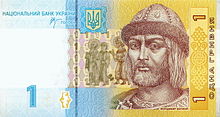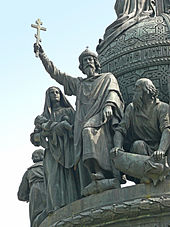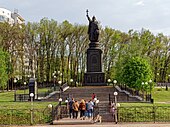Vladimir the Great
| Vladimir the Great | |||||
|---|---|---|---|---|---|
Spouse |
| ||||
| Issue among others | |||||
| |||||
Sviatoslav I of Kiev | |||||
| Mother | Malusha[4] | ||||
| Religion | Chalcedonian Christianity (from 988) prev. Slavic pagan | ||||
Equal to the Apostles | |
|---|---|
| Born | c. 958 |
| Died | 15 July 1015 |
| Venerated in | Eastern Orthodox Church[5] Catholic Church[6] Anglican Communion Lutheranism[7] |
| Feast | 15 July |
| Attributes | Crown, cross, throne |
Vladimir I Sviatoslavich or Volodymyr I Sviatoslavych
Vladimir's father was
Name
Several scholars refer to Vladimir as Volodimer,[23][24][25][26] also spelled Volodimir,[27][c] and his descendants as Volodimerovichi (sometimes in lieu of "Rurikids").[29][30] In the history of Scandinavia, Vladimir is also known as Valdemar or the Old Norse form Valdamarr (see Waldemar).[31][32][33][34]
Rise to power
Born in 958, Vladimir was the
Transferring his capital to
Years of pagan rule
Vladimir continued to expand his territories beyond his father's extensive domain. In 981, he seized the
Although Christianity had spread in the region under Oleg's rule, Vladimir had remained a thoroughgoing pagan, taking eight hundred concubines (along with numerous wives) and erecting pagan statues and shrines to gods.[42]
He may have attempted to reform
Open abuse of the deities that most people in Rus' revered triggered widespread indignation. A mob killed the Christian Fyodor and his son Ioann (later, after the overall Christianisation of Kievan Rus', people came to regard these two as the first Christian martyrs in Rus', and the Orthodox Church set a day to commemorate them, 25 July[44]). Immediately after the murder of Fyodor and Ioann, early medieval Rus' saw persecutions against Christians, many of whom escaped or concealed their belief.[d]
However, Prince Vladimir mused over the incident long after, and not least for political considerations. According to the early Slavic chronicle, the Tale of Bygone Years, which describes life in Kievan Rus' up to the year 1110, he sent his envoys throughout the world to assess first-hand the major religions of the time: Islam, Latin Christianity, Judaism, and Byzantine Christianity.[45] They were most impressed with their visit to Constantinople, saying, "We knew not whether we were in Heaven or on Earth ... We only know that God dwells there among the people, and their service is fairer than the ceremonies of other nations."[46]
Conversion

The Primary Chronicle reports that in the year 986, missionaries from various peoples representing various religions arrived in Kiev, trying to convert Vladimir to their religion. In 987, after consultation with his boyars, Vladimir reportedly sent envoys to study the religions of the various neighboring peoples whose representatives had been urging him to embrace their respective faiths. Although in both stories Vladimir ultimately rejects all options except Eastern Christianity, he hesitates and does not convert.[47]
In 988, having taken the town of
Christianization of Kievan Rus'
Returning to Kiev in triumph, Vladimir
In 988 and 991, he baptized
Christian reign
Vladimir then formed a great council out of his boyars and set his
In his later years he lived in relative peace with his other neighbors:
In 1014, his son Yaroslav the Wise stopped paying tribute. Vladimir decided to chastise the insolence of his son and began gathering troops against him. Vladimir fell ill, however, most likely of old age, and died at Berestove, near modern-day Kiev. The various parts of his dismembered body were distributed among his numerous sacred foundations and were venerated as relics.[35]
During his Christian reign, Vladimir lived the teachings of the Bible through acts of charity. He would hand out food and drink to the less fortunate, and made an effort to go out to the people who could not reach him. His work was based on the impulse to help one's neighbors by sharing the burden of carrying their cross.[54] He founded numerous churches, including the Desyatynna Tserkva (Church, or Cathedral, of the Tithes) (989), established schools, protected the poor and introduced ecclesiastical courts. He lived mostly at peace with his neighbors, the incursions of the Pechenegs alone disturbing his tranquility.[35]
He introduced the
Family

The fate of all Vladimir's daughters, whose number is around nine, is uncertain. His wives, concubines, and their children were as follows:
- Varangian or Czech), speculative; she might have been mother of Vysheslav while others claim that it is a confusion with Helena Lekapene
- Vysheslav (c. 977 – c. 1010), Prince of Novgorod (988–1010)[56]
- Irina, a widow of Yaropolk I, a Greek nun
- Sviatopolk the Accursed (born c. 979), possibly the surviving son of Yaropolk
- Rogneda (the daughter of Rogvolod); later upon divorce she entered a convent taking the Christian name of Anastasia
- Izyaslav of Polotsk(born c. 979, Kiev), Prince of Polotsk (989–1001)
- Tale of Bygone Years and not as it was officially known. A later analysis of his skeletal remains also corroborates this view.[60]
- Vsevolod (c. 984 – 1013), possibly the Swedish Prince Wissawald of Volhynia (c. 1000), was perhaps the first husband of Estrid Svendsdatter
- Mstislav, distinct from Mstislav of Chernigov, possibly died as an infant, if he was ever born
- Chernigov (1024–1036), other sources claim him to be the son of other mothers (Adela, Malfrida, or some other Bulgarian wife)
- Predslava, a Bolesław I Chrobry according to Gesta principum Polonorum
- Premislava, (died 1015), some sources state that she was a wife of the Duke Laszlo (Vladislav) "the Bald" of the Arpadians
- Mstislava, in 1018 was taken by Bolesław I Chrobryamong the other daughters
- Bulgarian Adela, some sources claim that Adela is not necessarily Bulgarian as Boris and Gleb may have been born from some other wife
- Volga Bolgars
- Gleb (born c. 987), Prince of Murom (1013–1015), as is Boris, Gleb is also claimed to be the son of Anna Porphyrogenita.[61]
- Stanislav (born c. 985 – 1015), Prince of Smolensk (988–1015), possibly of another wife and the fate of whom is not certain
- Nikon's Chronicles. He spent 35 years in prison and later became a monk.
- Malfrida
- Sviatoslav (c. 982 – 1015), Prince of Drevlians (990–1015)
- Anna Porphyrogenita
- Theophana, a wife of Novgorod posadnik Ostromir, a grandson of semi-legendary Dobrynya[61] (highly doubtful is the fact of her being Anna's offspring)[citation needed]
- a granddaughter of Otto the Great (possibly Rechlinda Otona [Regelindis])
- Maria Dobroniega of Kiev (born c. 1012), the Duchess of Poland (1040–1087), married around 1040 to Casimir I the Restorer, Duke of Poland, her maternity as daughter of this wife is deduced from her apparent age
- other possible family
- Vladimirovna, an out-of-marriage daughter (died 1044), married to Bernard, Margrave of the Nordmark.
- Pozvizd (born prior to 988), a son of Vladimir according to Hustyn Chronicles. He, possibly, was the Prince Khrisokhir mentioned by Niketas Choniates.
Significance and legacy

The
The town
The memory of Vladimir was also kept alive by innumerable Russian folk ballads and legends, which refer to him as Krasno Solnyshko (the Fair Sun, or the Red Sun; Красно Солнышко in Russian). The
The appropriation of Kievan Rus' as part of national history has also been a topic of contention in
All branches of the economy prospered under Vladimir.[67] He minted coins and regulated foreign affairs with other countries, such as trade, bringing in Greek wines, Baghdad spices, and Arabian horses for the markets of Kiev.
-
Monument to Volodymyr the Great in Kyiv
-
Vladimir the Great on theNovgorod
-
Monument to Vladimir the Great and the monk Fyodor at Pushkin Park in Vladimir, Russia
-
St Vladimir the Great Monument in Belgorod, Russia
-
Monument to Prince Vladimir (Novocheboksarsk)
-
Ukrainians in Great Britainin 1988 to celebrate the establishment of Christianity in Ukraine by St. Volodymyr in 988
-
Statue in Toronto erected by Ukrainians in Canada in 1988 to celebrate the establishment of Christianity in Ukraine by St. Volodymyr in 988
See also
- Order of Saint Vladimir
- List of Russian monarchs
- List of leaders of Ukraine
- Family life and children of Vladimir I
- List of people known as The Great
- Monument to Prince Volodymyr in Kyiv (1853)
- Monument to Vladimir the Great (Moscow) in 2016
- Prince Vladimir, Russian animated feature film (2006)
- Viking, Russian historical film (2016), where Vladimir the Great is portrayed by Danila Kozlovsky
Notes
- Old Bulgarian (Old Church Slavonic) form Vladiměrъ (by folk etymology later also Vladimirъ; in modern East Slavic languages, the given name is rendered Belarusian: Уладзiмiр, Uladzimir, Russian: Владимир, Vladimir, Ukrainian: Володимир, Volodymyr. See Vladimir (name)for details.
- Old Norse Valdamarr gamli;[9]
- ^ According to historian Donald Ostrowski (2017), Russian scholars tend to prefer "Vladimir", while Ukrainian scholars tend to prefer "Volodimer". However, "Volodimir" tends to occur as much in the primary sources as "Volodimer", and significantly more often than "Vladimir".[28]
- ^ In 983, after another of his military successes, Prince Vladimir and his army thought it necessary to sacrifice human lives to the gods. A lot was cast and it fell on a youth, Ioann by name, the son of a Christian, Fyodor. His father stood firmly against his son being sacrificed to the idols. Further, he tried to show the pagans the futility of their faith: "Your gods are just plain wood: it is here now but it may rot into oblivion tomorrow; your gods neither eat, nor drink, nor talk and are made by human hand from wood; whereas there is only one God – He is worshiped by Greeks and He created heaven and earth; and your gods? They have created nothing, for they have been created themselves; never will I give my son to the devils!"[citation needed]
References
- ISBN 978-1-442203-02-0.
- ^ Александров А. А. Ольгинская топонимика, выбутские сопки и руссы в Псковской земле // Памятники средневековой культуры. Открытия и версии. СПб., 1994. С. 22—31.
- (PDF) from the original on 9 October 2022. Retrieved 7 January 2018.
- ^ Harvard Ukrainian studies, Vol. 12–13, p. 190, Harvard Ukrainian studies, 1990
- ISBN 9781914337031.
- ISBN 9781317466048.
- ^ "Notable Lutheran Saints". Resurrectionpeople.org. Archived from the original on 16 May 2019. Retrieved 16 July 2019.
- ^ "Час побудови собору". 26 May 2020.
- ^ Fagrskinna ch. 21 (ed. Finnur Jónsson 1902–8, p. 108).
- ISBN 978-5-04-107383-1.
- ISBN 978-1-4443-2002-2.
- ^ "Volodymyr the Great". Internet Encyclopedia of Ukraine. Retrieved 29 March 2022.
- ^ ISBN 978-90-04-35214-8.
- ^ ISBN 978-90-04-26022-1.
- ^ Companion to the Calendar: A Guide to the Saints and Mysteries of the Christian Calendar, p. 105, Mary Ellen Hynes, Ed. Peter Mazar, LiturgyTrainingPublications, 1993
- ISBN 978-0-520-07945-8.
- ^ a b Vladimir I (Grand Prince of Kiev) at the Encyclopædia Britannica
- ^ ISBN 978-0-521-36832-2.
- ^ Vladimir the Great, Encyclopedia of Ukraine
- ^ Saint Vladimir the Baptizer: Wetting cultural appetites for the Gospel, Dr. Alexander Roman, Ukrainian Orthodoxy website
- ^ Ukrainian Catholic Church: part 1., The Free Library
- ^ National geographic, Vol. 167, p. 290, National Geographic Society, 1985
- ^ Franklin 1991, p. 3.
- ^ Ostrowski 2006, p. 568.
- ^ Halperin 2022, p. 15.
- ISBN 9781501757402. Retrieved 6 March 2023.
- ^ Ostrowski 2018, p. 33.
- )
- ^ Raffensperger 2016, p. 9.
- ^ Halperin 2022, p. viii.
- ISBN 978-90-04-36381-6.
- ISBN 978-1-000-03734-0.
- ISBN 978-0-521-64398-6.
- ISBN 978-1-108-01615-5.
- ^ a b c d e f g Bain 1911.
- ^ Kovalenko, Volodymyr. "Young years of Volodymyr Svyatoslavych: the path to the Kyiv throne in the light of the theories of A. Adler - E. Erikson". Bulletin of the Chernihiv National Pedagogical University. Series: Historical sciences. 2015 (134): 10–18.
- ISBN 978-1-317-89720-0.
- ISBN 978-1-5017-2762-7.
- Den Katolske Kirke
- ^ Janet Martin. Medieval Russia. Cambridge University Press. 1995. pp. 5, 15, 20.
- ^ John Channon, Robert Hudson. The Penguin historical atlas of Russia. Viking. 1995. p. 23.
- ^ "Although Christianity in Kiev existed before Vladimir's time, he had remained a pagan, accumulated about seven wives, established temples, and, it is said, taken part in idolatrous rites involving human sacrifice." (Encyclopædia Britannica)
- OCLC 761647272.
- ^ "On July 25, the church honors the first holy martyrs of Kievan Rus".
- ^ Bury, John Bagnell (1923). The Cambridge Medieval History. Vol. IV. 308 Cambridge: University Press.
- ^ Thomas Riha (2009).
Readings in Russian Civilization, Volume 1: Russia Before Peter the Great, 900–1700. University of Chicago Press. ISBN 9780226718439.
- ^ Ostrowski 2006, pp. 568–569.
- ^ The Earliest Mediaeval Churches of Kiev, Samuel H. Cross, H. V. Morgilevski and K. J. Conant, Speculum, Vol. 11, No. 4 (Oct., 1936), 479.
- ^ Ibn al-Athir dates these events to 985 or 986 in his The Complete History
- ^ "Rus". Encyclopaedia of Islam
- ^ The Earliest Mediaeval Churches of Kiev, Samuel H. Cross, H. V. Morgilevski and K. J. Conant, Speculum, 481.
- ISBN 9789047423560. Retrieved 14 May 2016.
- ^ "The Russian Primary Chronicle".
- ^ Obolensky, Alexander (1993). "From First to Third Millennium: The Social Christianity of St. Vladimir of Kiev". Cross Currents.
- ISBN 978-0-14-192500-4.
- ISBN 978-90-04-35214-8.
- ^ Pchelov, E.V. (2002). Rurikovichi: Istoriya dinastii (Online edition (No longer available) ed.). Moscow.
{{cite book}}: CS1 maint: location missing publisher (link) - ^ William Humphreys, "Agatha, mother of St. Margaret: the Slavic versus the Salian solutions - a critical overview", Foundations, 1(1):31-43; Joseph Edwards, "Editorial", Foundations, 1(2):74; William Humphreys, "Agatha ‘the Greek’ – Exploring the Slavic solution", Foundations, 1(4):275-288.
- ^ Arrignon, Jean Pierre (1983). Les relations diplomatiques entre Bizance et la Russie de 860 à 1043. Revue des études slaves 55. pp. 133-135.
- ISBN 5-9533-1256-3.
- ^ ISBN 9789004120976. Retrieved January 27, 2013.
- ^ "St. Vladimir". Retrieved 13 May 2017.
- ^ День Св. Володимира Великого, християнського правителя (in Ukrainian). Ukrainian Lutheran Church. 28 July 2014. Retrieved 19 September 2018.
- ^ Henryk Paszkiewicz. The making of the Russian nation. Greenwood Press. 1977. Cracow 1996, pp. 77–79.
- ^ С. В. Шевченко (ред.). К вопросу о дате основания г. Владимира, ТОО "Местное время", 1992. (S. V. Shevchenko (ed.). On the foundation date of Vladimir. in Russian)
- ^ A tale of two Vladimirs, The Economist (5 November 2015)
From one Vladimir to another: Putin unveils huge statue in Moscow, The Guardian (5 November 2015)
Putin unveils 'provocative' Moscow statue of St Vladimir, BBC News (5 November 2016) - ^ Volkoff, Vladimir (2011). Vladimir the Russian Viking. New York: Overlook Press.
Bibliography
- Golden, P. B. (2006) "Rus." Encyclopaedia of Islam (Brill Online). Eds.: P. Bearman, Th. Bianquis, C.E. Bosworth, E. van Donzel and W.P. Heinrichs. Brill.
- This article incorporates text from a publication now in the public domain: Bain, Robert Nisbet (1911). "Vladimir, St". In Chisholm, Hugh (ed.). Encyclopædia Britannica. Vol. 28 (11th ed.). Cambridge University Press. p. 168.
- Franklin, Simon (1991). "Ilarion's "Sermon on Law and Grace"". Sermons and Rhetoric of Kievan Rus' (PDF). University of Toronto (SLA 218 Ukrainian Literature and Culture). p. 30. Retrieved 6 March 2023.
- Halperin, Charles J. (2022). The Rise and Demise of the Myth of the Rus' Land (PDF). Leeds: Arc Humanities Press. p. 107. ISBN 9781802700565. Retrieved 6 March 2023.
- Some historical analysis and political insights on the state affairs of Vladimir the Great (in Russian)
- Moss, Walter (2002). A history of Russia. London: Anthem. OCLC 53250380.
- Ostrowski, Donald (2006). "The Account of Volodimer's Conversion in the "Povest' vremennykh let": A Chiasmus of Stories". Harvard Ukrainian Studies. 28 (1–4). Harvard Ukrainian Research Institute: 567–580. JSTOR 41036982. Retrieved 6 May 2023.
- Ostrowski, Donald (2018). "Was There a Riurikid Dynasty in Early Rus'?". Canadian-American Slavic Studies. 52 (1): 30–49. .
- Raffensperger, Christian (2016). Ties of Kinship: Genealogy and Dynastic Marriage in Kyivan Rus'. Cambridge, Massachusetts: Harvard Ukrainian Research Institute. p. 418. ISBN 9781932650136.
External links
- Velychenko, Stephen, How Valdamarr Sveinaldsson got to Moscow (krytyka.com), 9 November 2015.










